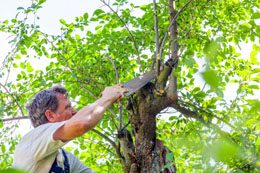Topping is a tree pruning practice. Despite being harmful for the trees, it is widely practiced everywhere. This article explains why it is not an acceptable pruning technique.

The practice of tree topping is one of the most widely debated exercise. Those who believe that it is the best and the most appropriate way to trim trees, are pitted against the environmentalists, who believe that the trees are harmed and the practice must be suspended, and the offenders should be punished.
Tree Topping Explained
It is defined as the practice of getting rid of large branches and trunks from the part close to the summit of a tree's canopy. It is nothing but an arbitrary removal of all parts of the tree beyond a certain threshold height, while ignoring the structure or growth pattern of a tree.
Several new techniques are being used all over the world, that are very harmful for the trees for a variety of practical and aesthetic reasons. It has been established that topping of trees can cause a variety of problems in trees, which can ultimately be disadvantageous for those responsible for culling these trees.
Why Do It?
People have quoted many reasons for resorting to this technique. Here are some misconceptions that make people go for topping.
- Obstruction to Power Lines: This is probably the most common reason why this practice is followed. Trees should ideally not touch the power lines, power loss could occur due to the fact that trees are good conductors of electricity. This problem can be resolved by planting proper species or better placement of trees or power lines. Topping for power line clearance will only benefit the lines, but will be fatal for the trees.
- Tree Grows Too Tall: A tree may be blocking a scenic view, shading the garden, or interfering with the solar energy collection process.
- Topping will Reduce the Effect of Storm: Large trees are inherently resistant to storms. If the tree is topped, there is reduction in height, which may reduce the risk temporarily. But as the tree regrows it loses its structural strength and the risk is elevated.
What are the Consequences?
There are many ways in which a tree is affected, when it is topped. Here are the few most commonly observed ill-effects:
- The balance between the roots and the upper branches of a tree might get disturbed due to this practice. If too many branches and leaves are culled during the process, trees can starve.
- Regrowing trees have weaker branches and this creates a storm hazard. Storms can damage the tree further, as the new growth is weakly attached.
- Bark tissues suddenly exposed to the sun may burn, causing sun scald, and develop disease cankers.
- Stubs get separated from food and water supply as tissues die. This hampers the healing of wounds and a decay may spread to the trunk.
- Topping causes disfiguring of trees by altering their natural beauty and form.
How to Avoid?
It is important to avoid this practice at all costs. Proper selection of the right tree and planting it in the right place is a step in this direction. Avoid laying of power lines in a way that will obstruct a tree's growth. If the lines cannot be relocated, carefully remove the whole tree and relocate it. Proper pruning of trees can be adopted. This involves the removal of the limbs from wherever they are attached to the trunk. This method of selective removal of limbs drastically reduces the wind resistance of the tree, and allows some light to get to the tree crown, thereby improving the shape and balance of the crown.
People should come together and pledge to discourage the practice of topping. It can cause a lot of damage to the tree by causing decay, storm damage, and disfiguring trees. Instead we can imply proper a pruning technique which is the best practice for promoting the long-term health of the trees.






 The practice of tree topping is one of the most widely debated exercise. Those who believe that it is the best and the most appropriate way to trim trees, are pitted against the environmentalists, who believe that the trees are harmed and the practice must be suspended, and the offenders should be punished.
The practice of tree topping is one of the most widely debated exercise. Those who believe that it is the best and the most appropriate way to trim trees, are pitted against the environmentalists, who believe that the trees are harmed and the practice must be suspended, and the offenders should be punished.